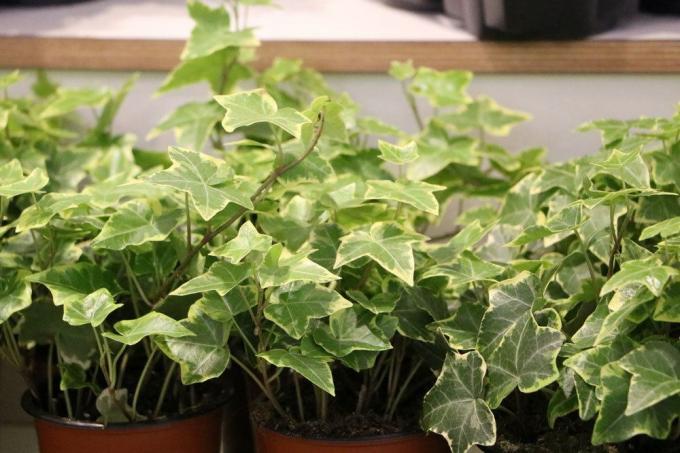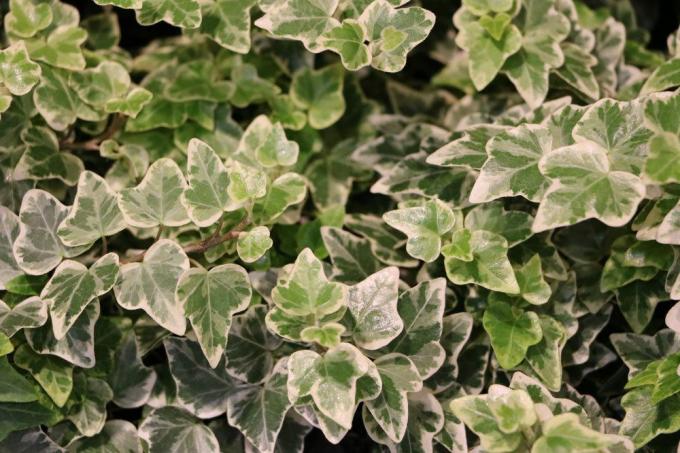
table of contents
- growth
- Young plant
- Speeds
- Age form
- Sizes
Ivy, especially the common ivy Hedera helix, is known for its rapid growth and the ability to attach itself to all possible surfaces without major problems. Within a few years, a single cutting can green an entire house wall. Because of the speed of the ivy, it is popular as a hedge plant and ground cover, but if not cared for properly, it can become a real "weed". Therefore, it is good to know how fast ivy grows.
growth
Two meters in a year
The growth of an ivy takes place in several stages and enables the plant to reach a life span of 400 to 500 years. The oldest European specimen of an ivy still alive today can be found in the Zehdenick Monastery near Brandenburg, which was disbanded in 1541. Although the associated dormitory was destroyed in a fire in the 19th Lost the entire roof in the 19th century, the ivy still exists today and frames most of the building. Some experts estimate its age to be around 700 years. This feat shows how enduring ivy is.

The plant enables this through the following stages:
- Young plant (two years)
- medium growing time
- Age form (from around ten years)
Despite this strong growth, even ivy has its limits. Its typical growth rate is up to 200 centimeters per year if the following characteristics are present.
- constantly moist soil
- no waterlogging
- Time
The ivy can either grow in height or width, the plant doesn't care. For this reason, the climbing plant can cause great damage in the garden and on facades without a cut. But it is precisely this joy of growth that makes it so popular as a hedge and ornamental plant with many gardening enthusiasts. The ivy hardly needs any nutrients, sun or care to grow two meters a year. You should also not worry if the ivy is gracing about its growth for the first few years. This is typical for young specimens.
Young plant
Young plant growth
Hedera helix is a climbing plant that really wants to explore new terrain, but needs time to do so. The cuttings are grown either in water or in a pot of soil in autumn and develop roots in the process. The young plants come into the garden from spring and are extremely cautious in the first year. Ivy usually doesn't even grow half a meter in the first year. Depending on the temperature and location, the next two are just as restrained, but as the root formation in the soil increases, the superficial tendrils strengthen. Then it is time for the ivy to enter its second stage of development.
Tip: Hedera varieties are all moisture-loving and hardly need any sun to sprout as young plants. So you can lean back and relax in the first few years and do not have to do anything.

Speeds
Growth to age form
From around two to three years of age, the vigorous growth for which ivy is known begins. Depending on the location, the growth rates vary per year as shown below.
ideal conditions (lots of shade with high humidity, permeable soil):
- more than 200 centimeters
too bright (lots of sun, damp soil, impending sunburn in winter):
- about 150 centimeters
bright and dry (lots of sun, low humidity, barren soil):
- under 100 centimeters
This means that the drier the surroundings of the Aralia family, the more it suffers from the conditions and can only sprout with difficulty. Over the years, however, the plant keeps growing in shoots and feels its way with the adhesive roots along the floor or façade. Above all, the ivy wants to escape the light and is therefore always looking for dark corners. Some ivy can gain between five and ten meters in height or width without cutting. This also makes them so problematic if they are not controlled in the cut, as they tend to take root in the masonry.
Tip: You can cut ivy several times a year, thereby limiting the height or width. After a cut, you can also watch the new adhesive roots sprout, as ivy sprouts particularly quickly after a cut.

Age form
The age form explained
From an age of about ten to twenty years, ivy presents itself in the age form. This is a unique new growth form of the climbing plant.
- upright growth forms over the main root
- Trunk becomes visible
- grows in breadth
- is blooming
- Leaf shape is different compared to climbing ivy
The age form looks like a tree that suddenly grows out of the ground cover elements of the ivy. After the ivy has reached old age, it reduces growth by about half and drives out the trunk. From this time on, the growth is still very noticeable and the climbing plant does not stop there. That said, a cut is still required here so that the ivy does not occupy the facade of a house, which can easily be done after several decades. The age shape can easily be cut into any imaginable shape like a bush or a hedge
Note: From the age onwards, Hedera helix bears fruit that children can easily pick. Besides the leaves of ivy, these are poisonous and should just not get into the hands of children.

Sizes
Which sizes are achieved?
Ivy is a true master of sizes and there are many specimens that have reached gigantic proportions.
measured heights:
- average 20 to 30 meters, maximum height about 90 meters (few specimens that grow on trees in the USA)
measured widths:
- an average of over 30 meters
measured trunk diameter:
- typically between 30 and 60 centimeters, more rarely over 90 centimeters
However, ivy is limited to about 30 meters in height. The 90 meter giants are a collection of several ivy plants that are sprouting again at different points on the tree. That said, if you don't want your home to be devoured by the ivy, which is entirely possible, it is worth pruning every few weeks or months.



